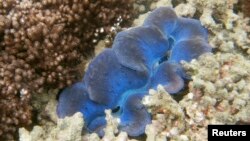SYDNEY —
Coral sperm in Australia's Great Barrier Reef is being cryogenically frozen to protect some of the animal species from extinction. A sperm bank has been set up hundreds of kilometers away at a zoo in the New South Wales outback that should allow researchers to re-introduce the samples into the Reef in the future.
The coral sperm bank is an insurance policy against the various threats that the Great Barrier Reef faces, such as warming temperatures, ocean acidification and pollution. Human fertility techniques are being used to deep freeze billions of sperm in liquid nitrogen. The cryogenic process was developed in Hawaii and could one day allow researchers to reseed vulnerable parts of Australia’s greatest natural treasure.
“I had been developing this technology in the United States and had successfully cryo-preserved coral sperm and embryonic cells there. But we thought that we could now start to actively apply this in terms of conservation in Australia and have it impact on the Great Barrier Reef,” said Dr. Mary Hagedorn, who is from the Smithsonian Institute.
The coral gene bank has been set up at the Western Plains Zoo in Dubbo in the state of New South Wales, many hundreds of kilometers from the reef.
Scientists say some of the samples could be stored for hundreds of years until such time as they are needed. Some samples have already been used to help fertilize new coral and replenish ailing parts of the Great Barrier Reef.
Dr. Rebecca Spindler, the zoo’s manager of research and conservation, said it was an exciting project.
“We fell in love with the coral work straight away, and I think then what we were able to provide was a really consistent, very good and secure way of keeping that coral forever,” she said.
Australia's Great Barrier Reef is a place like no other. It stretches for more than 2,000 kilometers down the continent’s northeast coast and is home to a fabulous collection of mollusks, fish, sea snakes and birds, not to mention a dazzling array of coral.
The World Heritage Area attracts more than two million visitors every year and is the only living thing visible with the naked eye from space.
The coral sperm bank is an insurance policy against the various threats that the Great Barrier Reef faces, such as warming temperatures, ocean acidification and pollution. Human fertility techniques are being used to deep freeze billions of sperm in liquid nitrogen. The cryogenic process was developed in Hawaii and could one day allow researchers to reseed vulnerable parts of Australia’s greatest natural treasure.
“I had been developing this technology in the United States and had successfully cryo-preserved coral sperm and embryonic cells there. But we thought that we could now start to actively apply this in terms of conservation in Australia and have it impact on the Great Barrier Reef,” said Dr. Mary Hagedorn, who is from the Smithsonian Institute.
The coral gene bank has been set up at the Western Plains Zoo in Dubbo in the state of New South Wales, many hundreds of kilometers from the reef.
Scientists say some of the samples could be stored for hundreds of years until such time as they are needed. Some samples have already been used to help fertilize new coral and replenish ailing parts of the Great Barrier Reef.
Dr. Rebecca Spindler, the zoo’s manager of research and conservation, said it was an exciting project.
“We fell in love with the coral work straight away, and I think then what we were able to provide was a really consistent, very good and secure way of keeping that coral forever,” she said.
Australia's Great Barrier Reef is a place like no other. It stretches for more than 2,000 kilometers down the continent’s northeast coast and is home to a fabulous collection of mollusks, fish, sea snakes and birds, not to mention a dazzling array of coral.
The World Heritage Area attracts more than two million visitors every year and is the only living thing visible with the naked eye from space.





